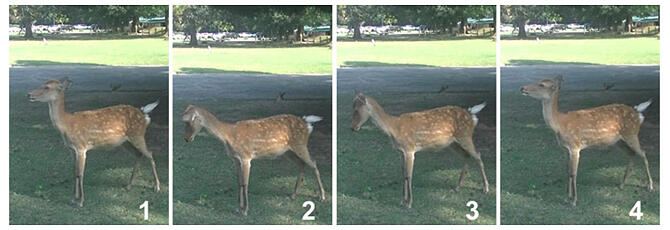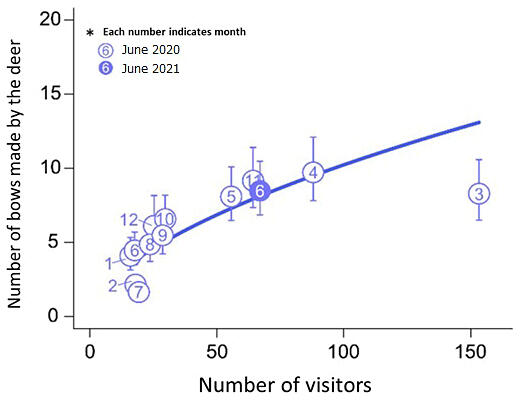The wild deer inhabiting Nara Park (Nara City) have ceased 'bowing' (the act of lowering their heads and ears) after the novel coronavirus (COVID-19) pandemic, as revealed by a research group of Nara Women's University and other organizations. As the number of visitors to Nara Park has decreased considerably, the number of deer showing up in the Park has also decreased. It is a well-known fact that animals have close relationships with the humans living around them, such as crows in residential areas scavenging kitchen waste. Despite this, the influence of decreased human activities on other living creatures has not been well researched nor reported.
Did they bow for 'Shika Senbei' rice crackers?
According to Professor Yoichi Yusa of Faculty Division of Natural Sciences, Nara Women's University, wild deer in nature appear to 'bow' (an act of lowering their heads) when they become stressed before an attack. By contrast, the deer inhabiting Nara Park and its surrounding areas come close to visitors and bow for 'Shika Senbei' rice crackers offered to them. The deer in Miyajima (Hatsukaichi City, Hiroshima Prefecture), a sightseeing spot that also allows the petting of deer, do not perform such behavior. It is only the deer living in Nara Park and its vicinity that bow in front of their feed. The deer in Nara Park are known to have no interaction with other deer and have their own ecosystem. Their act of bowing to people is unique to Nara and has not been seen anywhere else.

(provided by Nara Women's University)
Focusing on the COVID-19 pandemic: The relationship between humans and deer
Nara Women's University had a number of students who worked as part-timers for the tourism industry. In June 2020, the University faculty started the 'Grants for COVID-19 Pandemic or Post-COVID-19 Research,' project for which students whose earnings were reduced considerably were hired as research assistants to aid them financially.
Before the COVID-19 pandemic, Yusa had been in charge of a class on the bowing of deer as well as a practice course to count the number of deer once a year. He made use of the grant project and hired some undergraduate students to count the number of deer in Nara Park every month from June 2020 to June 2021, which was a higher enumeration frequency than before. Additionally, for his research, he purchased one hundred thousand yen of Shika Senbei rice crackers (200 yen for 10 pieces) and employed one student to show the crackers to deer and another to shoot videos of the bowing. In this way, they were able to count the number of bowing instances.
As a result, they found that in one session of research in 2020, when the pandemic was so intense that the park was almost deserted, the visible number of deer in Nara Park was as low as 65 on average. By contrast, the average number had been 167 in 2019, when there were many visitors to Nara City. Not only the humans, but also the deer had been avoiding close contact.
Moreover, the number of bows made by 20 randomly chosen deer was counted. They made 10.2 bows on average from September 2016 to January 2017, before the pandemic. This number decreased to 6.4 on average during the pandemic research period (June 2020 to June 2021).

(provided by Nara Women's University)

(provided by Nara Women's University)
Aoniyoshi: Nara's deer learned to coexist with humans
In nature, wild deer eat grass, acorns, and fallen leaves. Shika Senbei rice crackers, being made of rice bran, cover only approximately 2 percent of the deer's food, essentially making it their snack. Therefore, the deer will not starve to death even if the number of visitors decreases.
Only the deer in Nara Park bow. Yusa has the following hypothesis about this: "A long time ago, the deer in the capital Nara were afraid of humans, so they might have started bowing as a result of being stressed. However, the city gradually became a sightseeing spot and the deer learned to bow to people to get Shika Senbei rice crackers. Therefore, they began to bow to ask for the crackers." According to Yusa, these bowing behaviors have been passed from the parents to the fawns.
As Yusa stated, "During the COVID-19 pandemic, there were some interesting reports overseas. One article reported that the birds living in a residential area began to chirp after the people ceased to go outdoors. What will happen to the behaviors acquired by wild animals through their interactions with humans once those interactions cease to exist? There may be more influences we don't know of yet." He talks about the significance of advancing his research. Their findings were published online on May 16 in PLOS ONE, a U.S. science magazine.
To determine whether the number of deer appearing in Nara Park and the number of times they bow will increase to pre-pandemic levels, Yusa said that he and his team will carry on their observations in the coming months, as the number of visitors to the Park is gradually recovering.
Some say that it is not very good for wild animals to be under the influence of humans; however, the interactions between animals and humans are an issue that cannot be abandoned as long as all live on the same land. A symbiotic association with animals is desired for comfortable cohabitation between humans and animals. If we regard the bowing of the deer in Nara Park, which could be influenced by the number of visitors, as a means of communication between humans and animals, it seems that the challenge is to think of ways to appreciate the animals while protecting them.
(TAKIYAMA Nobuyo / Science Portal Editorial Office)
Original article was provided by the Science Portal and has been translated by Science Japan.




